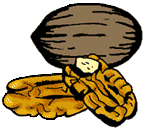 Growing and Harvesting Pecans - January 2, 2008 Jeff Schalau, Associate Agent, Agriculture & Natural Resources, Arizona Cooperative Extension, Yavapai County Pecan trees make an excellent shade tree and will produce a good crop in several areas of the Verde Valley. They are relatives of the hickory and native to the southern and Midwestern United States and northern Mexico. Camp Verde has close to 200 acres in pecans that produce approximately 200,000 lbs of pecans annually. Pecan trees continue to be planted in the area. Deep alluvial soils found on river and stream terraces are the best sites for pecans in the Verde Valley. Whatever the soil conditions, good drainage is the most critical factor when selecting suitable sites. Caliche layers should be well broken up before planting. In addition, sites above 3,500 feet in elevation are not suitable for pecans. They may experience spring frost injury, freeze damage and produce poor crops. This includes the cooler, higher elevation sites in Sedona. Pecans should be planted between January and mid-March. High quality, grafted (actually budded), bareroot trees of a suitable variety are best. Appropriate varieties include: Apache, Burkett, Choctaw, Cheyenne, Mohawk, Sioux, Wichita, and Western Schley. When planting, keep tree roots moist at all times, dig a hole at least three feet deep and two feet wide. Fill the hole half full with water, place the tree at the same depth as it was grown at the nursery, then add soil. The soil should force all air pockets out. After 24 hours, check to see if the soil has settled further. If so, add more soil and water. Many residents have one or more pecan trees planted on their property. Established pecan trees also require regular irrigation, fertilization, and pruning. These cultural practices are especially critical when trying to grow high quality nuts. When pecans are ready, they will release from the husk and drop to the ground where they should be collected as soon as possible (commercial growers use shakers and sweep the nuts from the ground). The Eighth Annual Camp Verde Pecan, Wine and Antique Festival will be held on February 8, 9 and 10, 2008. The Festival runs from noon to 6 PM on Friday the 8th, 9 AM to 5 PM on Saturday the 9th, and 10 AM to 4 PM on Sunday the 10th. The Festival is held in and around the Camp Verde Community Center (corner of Holloman and Main) and features locally grown pecans and pie, Arizona wineries (wine tasting), and antique vendors and displays. One of my favorite parts of the Festival is the Pecan Show. Here, pecans are judged by variety and the winner of each variety competes to become Grand and Reserve Champions. If you grow pecans, you should consider entering the Pecan Show. You will need a sample of 40 nuts in the shell harvested from a single tree/variety. Put your samples in a paper bag and bring them to the Camp Verde Parks and Recreation office (395 S. Main St.) on or before February 7, 2008. Pecans are judged based on: size, percent kernel (the percent of kernel in proportion to the whole nut), kernel color (actual color of the kernel with golden being ideal), in-shell appearance, uniformity (size and shape), number of whole kernel halves after shelling, and degree of insect/disease damage. For more specific instructions on how to prepare the best possible pecan show sample, visit the November 26, 2003 Backyard Gardener column. The Pecan, Wine and Antique Festival is an excellent opportunity to see and learn how to grow pecans. On Friday and Saturday, Dr. Mike Kilby, retired University of Arizona Fruit, Nut and Vine Specialist, will also be on hand to answer questions. I will also be there Friday and Saturday and Yavapai County Master Gardeners will be available to answer your gardening questions during the entire event. See you there! The University of Arizona Cooperative Extension has publications and information on gardening and pest control. If you have other gardening questions, call the Master Gardener line in the Cottonwood office at 646-9113 ext. 14 or E-mail us at cottonwoodmg@yahoo.com and be sure to include your address and phone number. Find past Backyard Gardener columns or submit column ideas at the Backyard Gardener web site: http://cals.arizona.edu/yavapai/anr/hort/byg/. |